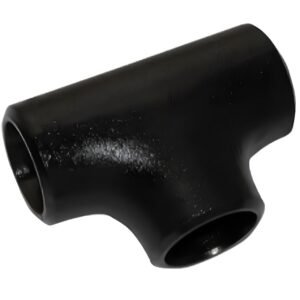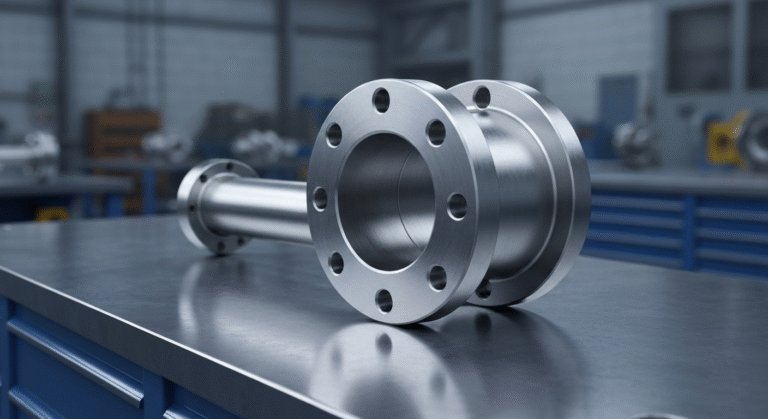-
Zona industrial de Yinzhuang, concelho de Mengcun, cidade de Cangzhou, província de Hebei, China
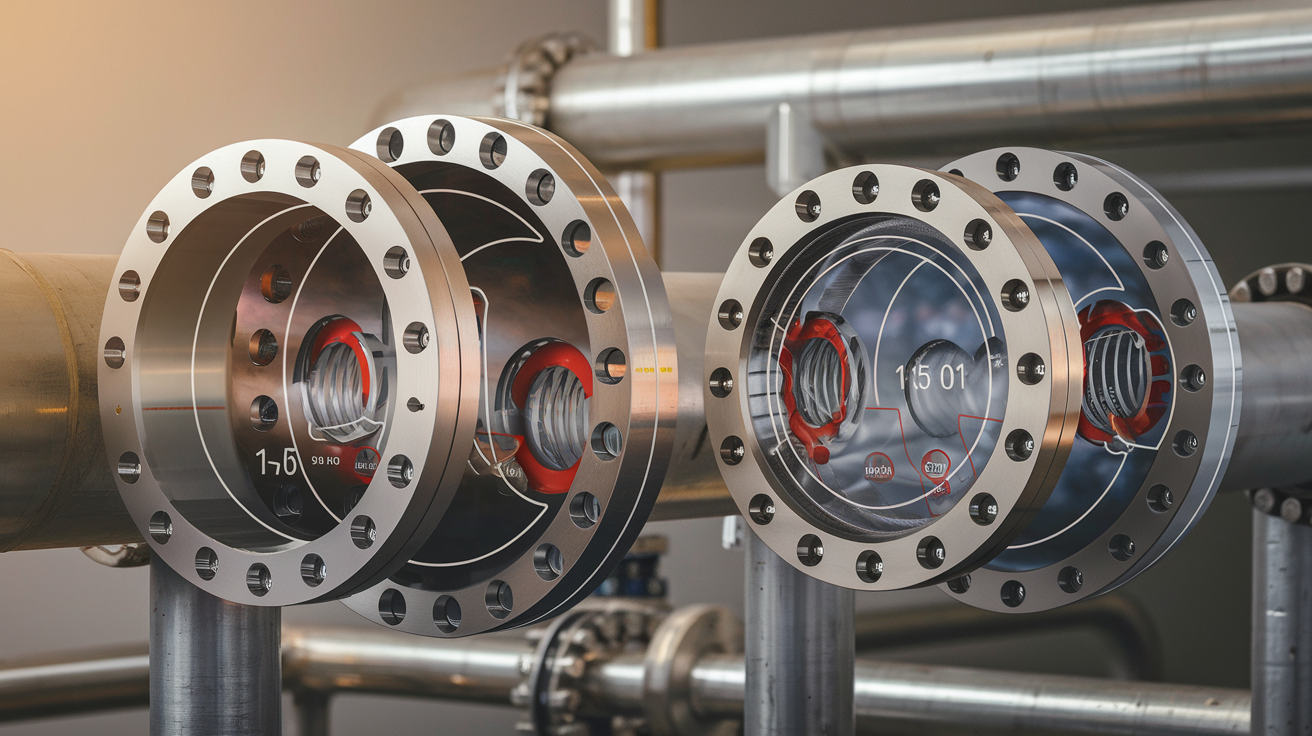
Flange WN vs. Flange Slip-On: Qual é o melhor?
Flange WN vs. Flange Slip-On: Qual é o melhor?
When designing piping systems, the choice between Weld Neck (WN) flanges e Slip-On flanges can significantly impact your project’s success, safety, and budget. While both serve the essential function of connecting pipes and components, their fundamental differences in design, installation requirements, and performance characteristics create a critical decision point for engineers and contractors. With one offering superior strength but at a higher cost, and the other providing installation simplicity but potential long-term compromises, choosing wrong could lead to premature system failure or unnecessary expense.
In the high-stakes environments of petrochemical processing, oil and gas transportation, or power generation, understanding when a WN flange’s superior strength—approximately one-third longer fatigue life than its slip-on counterpart—justifies its higher initial investment becomes crucial. Conversely, in less demanding applications like water treatment or HVAC systems, the slip-on flange’s cost-effectiveness and simpler installation might be the smarter choice. This comprehensive guide will examine the critical differences between these two flange types across installation processes, strength capabilities, cost considerations, and ideal applications, empowering you to make the optimal selection for your specific project requirements.
Understanding Flange Types and Their Designs
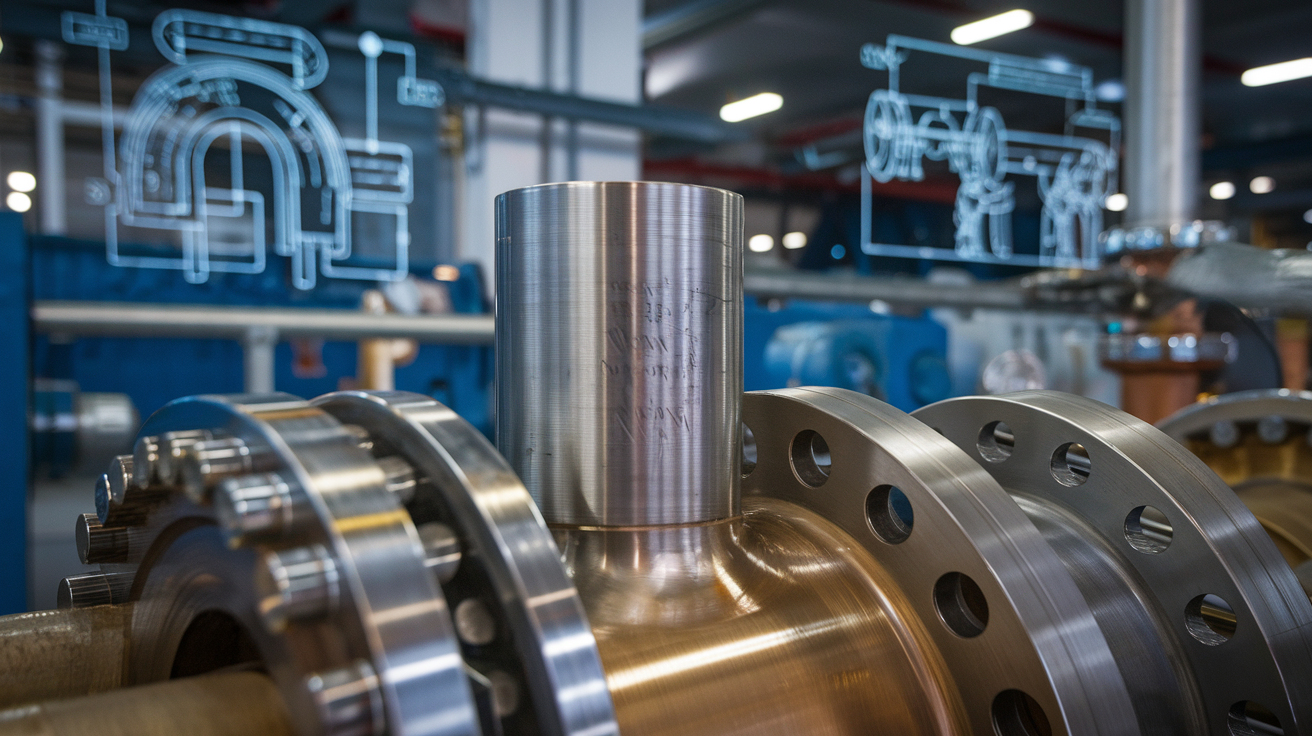
Understanding Flange Types and Their Designs
What is a Weld Neck (WN) Flange
A Weld Neck flange, commonly referred to as a WN flange, is characterized by its distinctive long, tapered hub design. This specialized structure enhances reinforcement and distributes stress more effectively throughout the connection point. The design allows for full-penetration butt welding on both the inside and outside, creating a seamless and robust joint with the pipe.
WN flanges are specifically engineered for high-pressure and high-temperature applications where reliability is crucial. Their design reduces turbulence and minimizes erosion within the pipeline system, making them ideal for critical industries such as oil and gas, petrochemicals, and power generation.
Key features of Weld Neck flanges include:
- Superior strength and durability
- Excellent resistance to thermal expansion
- High tolerance to mechanical stress
- Reduced risk of failure under extreme conditions
- Enhanced stress distribution through the tapered hub
What is a Slip-On Flange
A Slip-On flange features a bore diameter slightly larger than the pipe’s outer diameter, allowing it to slide or “slip” over the pipe during installation. This flange type is secured through fillet welding on both the inside and outside edges where the flange meets the pipe.
Slip-On flanges are more cost-effective solutions primarily designed for low to medium-pressure systems and moderate temperature applications. Their simpler design makes them particularly suitable for non-critical applications in industries such as water treatment and HVAC systems.
Key features of Slip-On flanges include:
- Easier and faster installation process
- Reduced precision requirements for pipe cutting
- Lower initial cost compared to WN flanges
- Simplified alignment during installation
- Versatility across various general industrial applications
Key Design Differences
The fundamental design differences between Weld Neck and Slip-On flanges significantly impact their performance, application suitability, and installation requirements:
| Caraterística | Weld Neck Flange | Slip-On Flange |
|---|---|---|
| Structure | Long, tapered hub | Simple, flat design |
| Welding Method | Butt-welding | Fillet welding (inside and outside) |
| Força | Elevado | Moderado |
| Stress Distribution | Excelente | Limited |
| Leakage Resistance | Superior | Moderate, more prone to leakage |
| Pressure Handling | High-pressure applications | Low to medium-pressure applications |
| Custo | Higher | Lower |
| Installation Complexity | Requires more skill and time | Simpler and faster |
Weld Neck flanges provide superior strength through their seamless connection with the pipe, distributing stress evenly and minimizing weak points. This makes them the preferred choice for critical applications involving extreme conditions, hazardous materials, or where system failure would have severe consequences.
In contrast, Slip-On flanges offer a more economical solution with simpler installation requirements, making them ideal for general industrial applications where budget constraints are a consideration and operating conditions are less demanding.
Now that we understand the fundamental designs and differences between these two flange types, let’s examine how these design characteristics impact their installation processes in the next section, “Installation Process Comparison.”
Installation Process Comparison
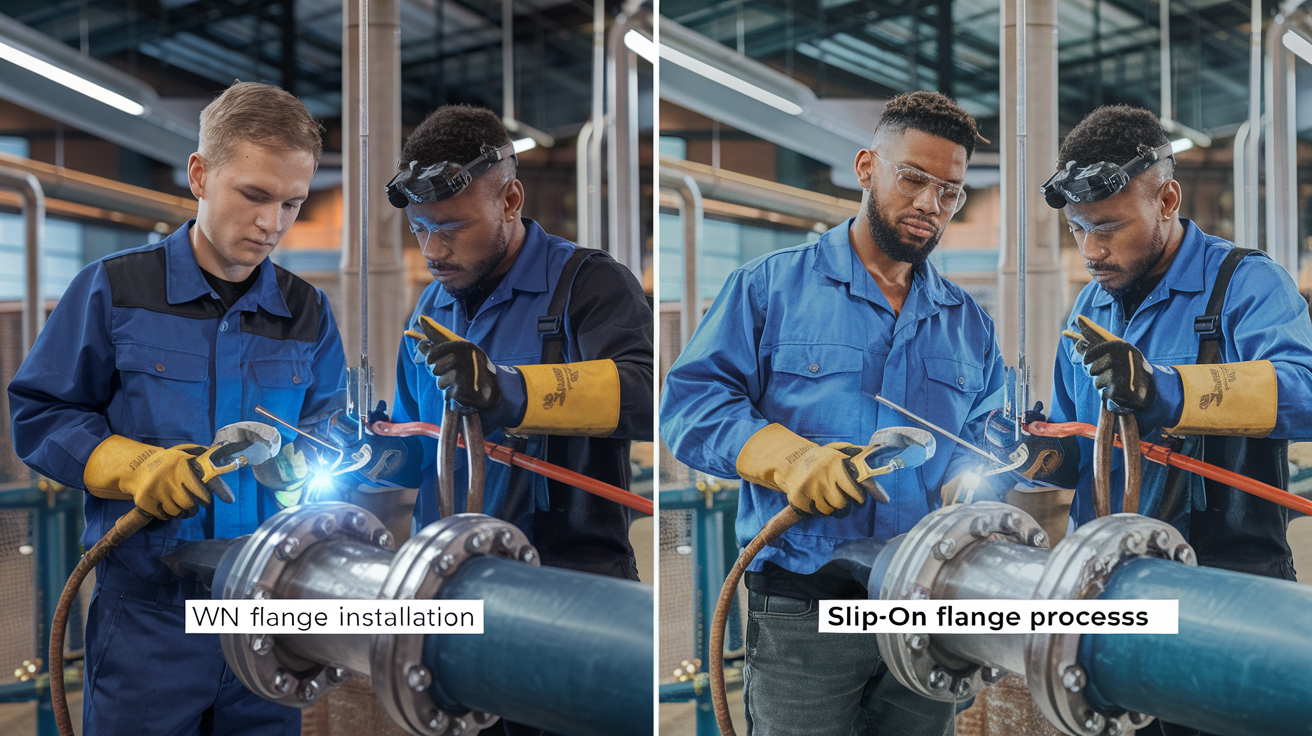
Installation Process Comparison
Now that we’ve explored the different flange types and their designs, let’s examine how WN flanges and slip-on flanges differ in their installation processes, which is a critical factor when selecting the appropriate flange for your piping system.
Weld Neck Installation Requirements
Weld neck flanges require a more complex installation process due to their design with a long, tapered hub. The installation involves:
- Full-penetration butt welding on both the inside and outside of the flange
- Precise alignment between the pipe and flange before welding
- More skilled welders with specialized training for proper installation
- Additional time for preparation and welding compared to other flange types
- Careful attention to ensure proper stress distribution throughout the connection
The butt welding technique used with WN flanges creates a seamless connection between the pipe and flange, resulting in superior strength and durability. However, this comes at the cost of more labor-intensive installation requirements and higher skilled labor costs.
Slip-On Installation Simplicity
Slip-on flanges offer significant advantages when it comes to ease of installation:
- The flange simply slides over the pipe, with its bore diameter slightly larger than the pipe’s outer diameter
- Alignment is easier and more forgiving during the installation process
- Welding occurs primarily on the outer edge with fillet welds on both the inside and outside
- Less precision is required when cutting pipes for slip-on flange installation
- Installation can be completed more quickly with less specialized labor
This simplified installation process is why slip-on flanges are often preferred for less critical applications and where budget constraints are a factor. The reduced labor requirements translate directly to cost savings during installation.
Welding Methods and Inspection Needs
The welding methods for these two flange types differ significantly:
Weld Neck Flanges:
- Require butt welding techniques that create full-penetration welds
- Need more rigorous inspection procedures to ensure weld integrity
- Often require radiographic or ultrasonic testing for critical applications
- May need post-weld heat treatment in high-stress applications
- Create less turbulence in the flow path due to the seamless transition
Slip-On Flanges:
- Utilize fillet welding on both inner and outer surfaces
- Have simpler inspection requirements for non-critical applications
- May have potential weak points due to the double welding requirement
- Generally require less extensive testing procedures
- Create potential flow restrictions or turbulence at the connection point
With this understanding of how each flange type is installed, we can now move on to examine their performance and strength characteristics, which directly relate to how these installation differences affect the long-term reliability of the piping system.
Performance and Strength Analysis
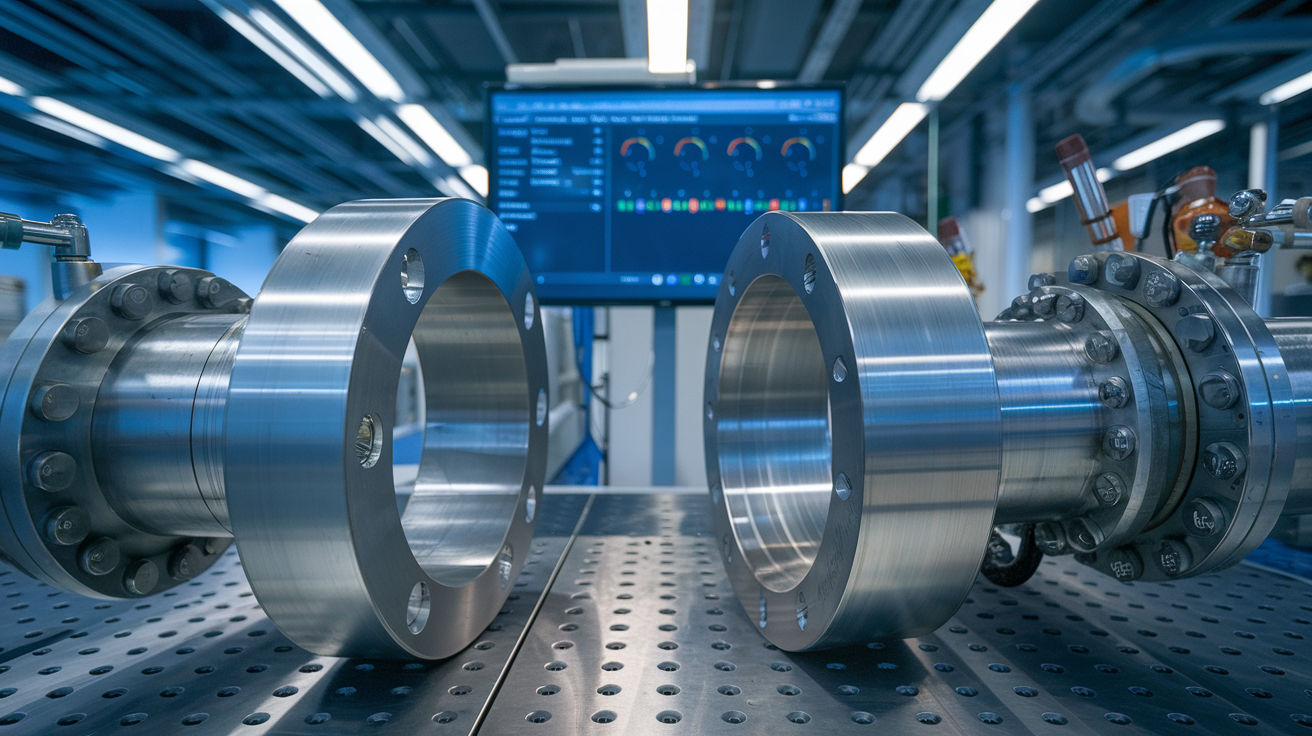
Performance and Strength Analysis
Now that we’ve explored the installation differences between WN flanges and slip-on flanges, let’s examine how these two flange types compare in terms of performance and strength—critical factors that ultimately determine their suitability for various applications.
Pressure and Temperature Resistance
WN flanges demonstrate superior pressure and temperature handling capabilities compared to slip-on alternatives. The tapered hub design of weld neck flanges allows for better stress distribution throughout the connection, making them ideal for high-pressure and high-temperature environments. This design feature enables WN flanges to withstand extreme temperature variations without compromising structural integrity.
In contrast, slip-on flanges offer limited pressure handling capabilities. Their calculated strength under internal pressure is approximately two-thirds that of weld neck flanges. This reduced strength makes slip-on flanges more suitable for low to medium-pressure systems where extreme conditions aren’t a concern.
Structural Integrity and Fatigue Life
The structural integrity of WN flanges significantly outperforms slip-on options due to their full-penetration butt weld design. This welding technique creates a seamless transition between the pipe and flange, distributing stress more evenly and reducing potential failure points.
A crucial difference is in fatigue life—slip-on flanges have approximately one-third the fatigue life of weld neck flanges. This substantial difference makes WN flanges the preferred choice for applications with cyclical loading or pressure fluctuations. The lower structural integrity of slip-on flanges is primarily due to potential weak points created by the double welding process (inside and outside), which can lead to increased risk of failure over time.
Flow Characteristics and Turbulence
Weld neck flanges minimize turbulence, erosion, and flow restriction within piping systems. The smooth, tapered design creates a more seamless transition for fluid flow compared to slip-on flanges. This reduction in turbulence is particularly important in high-velocity applications or systems where pressure drop must be minimized.
Slip-on flanges, with their recessed internal weld, can create minor flow disruptions that may contribute to increased turbulence. While this may not be significant in low-flow applications, it becomes an important consideration in critical systems where flow efficiency is paramount.
With these performance and strength factors in mind, next we’ll examine the cost considerations between these two flange types, as the performance benefits of WN flanges must be weighed against their higher initial investment.
Cost Considerations

Cost Considerations
Now that we’ve examined the performance and strength differences between WN flanges and slip-on flanges, it’s important to evaluate their economic impact. Cost considerations extend beyond just the initial purchase price and include installation and long-term expenses.
Initial Purchase Expenses
The initial cost difference between these flange types is significant:
Slip-On Flanges: Generally less expensive upfront, making them an attractive option for budget-conscious projects. Their simpler design requires less material and manufacturing time, resulting in lower purchase costs.
Weld Neck Flanges: Command a higher initial price due to their more complex design featuring a tapered hub. The additional material and manufacturing precision contribute to their premium price point.
According to the reference materials, slip-on flanges offer a more cost-effective initial investment, which makes them particularly appealing for non-critical applications and systems operating under lower pressure conditions.
Installation Labor and Time Costs
The installation process significantly impacts overall project expenses:
Slip-On Flanges:
- Easier and faster to install due to their simple slide-over design
- Require two welds (one on the inside and one on the outside)
- Need less precision for alignment, reducing labor requirements
- Lower skill level required for installation, potentially reducing labor costs
Weld Neck Flanges:
- Require more skilled welders for proper installation
- Need precise alignment for the full-penetration butt weld
- Take more time to install correctly
- Higher labor costs due to increased complexity and skill requirements
While slip-on flanges appear more economical during installation, it’s worth noting they require two welds and inspections, which can partially offset their labor savings.
Long-term Maintenance Economics
When considering the total cost of ownership:
Slip-On Flanges:
- More prone to leakage over time
- May require more frequent maintenance and replacement
- Higher potential for downtime in industrial applications
- Less durable in demanding environments, potentially leading to earlier replacement
Weld Neck Flanges:
- Superior durability reduces replacement frequency
- Better resistance to extreme conditions minimizes maintenance needs
- Lower likelihood of leakage reduces repair costs
- Longer service life offers better long-term value despite higher initial investment
For critical applications or systems operating under extreme conditions, the long-term economic benefits of weld neck flanges often outweigh their higher initial costs.
With these cost factors in mind, next we’ll explore the suitable applications for each flange type to help determine which option is better for specific operational requirements.
Suitable Applications for Each Flange Type
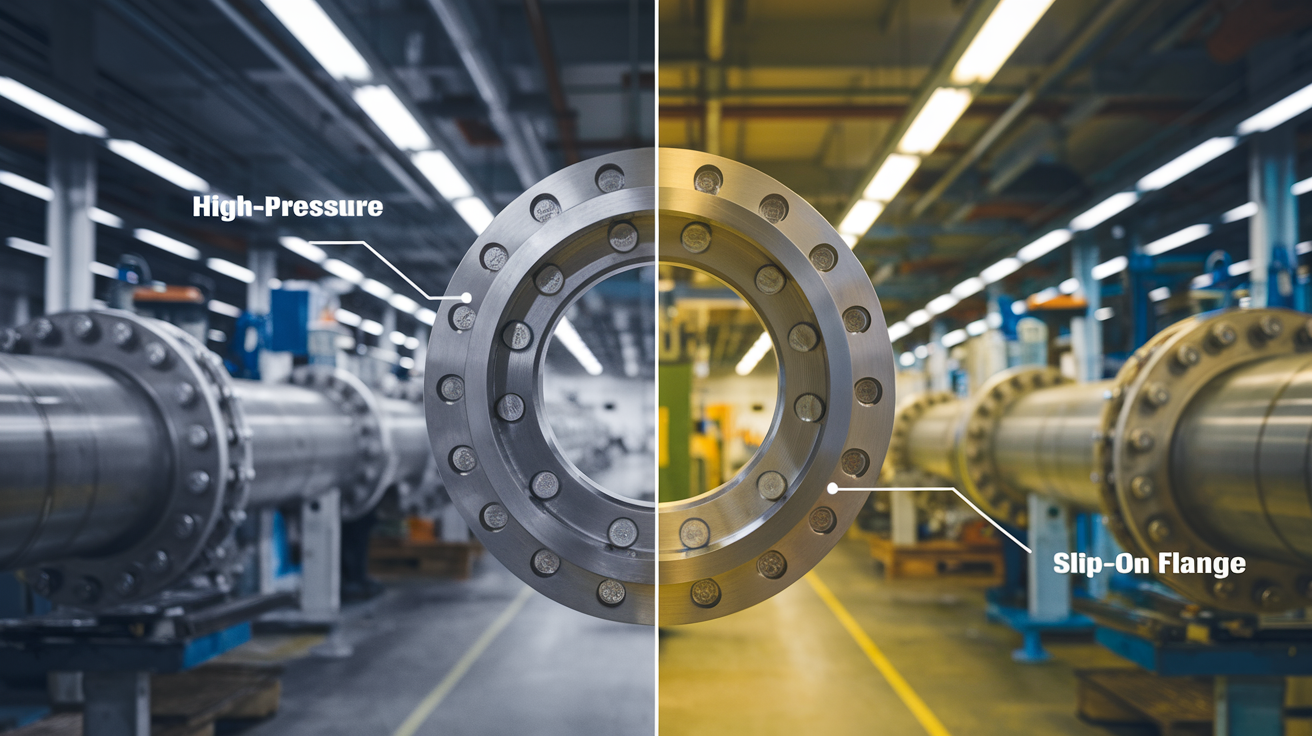
Suitable Applications for Each Flange Type
Now that we’ve covered the cost considerations of different flange types, let’s explore the specific applications where each type excels. Understanding which flange is most suitable for your particular situation can lead to better performance, longer service life, and more cost-effective operations in the long run.
Ideal Uses for Weld Neck Flanges
Weld neck flanges are the preferred choice for critical applications where safety and reliability are paramount:
- Sistemas de alta pressão: Due to their substantial strength and support, weld neck flanges are ideal for applications with elevated pressure ratings
- High-temperature environments: Their design provides superior performance in extreme temperature conditions
- Critical pipeline infrastructure: Used in major transmission lines and infrastructure where failure is not an option
- Larger pipe sizes: Recommended specifically for larger diameter piping systems
- Applications with stress concerns: The tapered neck distributes stress more evenly, reducing the risk of failure at the flange-pipe junction
In industries like oil and gas, chemical processing, and power generation, weld neck flanges are often the standard choice due to their robust construction and reliable performance under demanding conditions.
Best Applications for Slip-On Flanges
Slip-on flanges offer practical benefits in less demanding scenarios:
- Low-pressure applications: Ideal for systems operating at moderate to low pressures
- Non-critical services: Appropriate for auxiliary systems where occasional maintenance is acceptable
- Applications requiring frequent disassembly: Their design facilitates easier installation and removal
- Cost-sensitive projects: When budget constraints are a primary concern
- Systems with minimal stress or vibration: Best used in stable environments without significant mechanical stresses
These flanges are commonly found in water treatment facilities, HVAC systems, and general industrial piping where pressure and temperature demands are moderate.
Industry-Specific Recommendations
Different industries have developed standard practices for flange selection based on their unique requirements:
- Indústria do petróleo e do gás: Typically follows API 6A standards, with weld neck flanges preferred for wellheads, pipelines, and high-pressure processing equipment
- Processamento químico: Requires careful material compatibility considerations, often using weld neck flanges for hazardous materials
- Produção de energia: Uses weld neck flanges for steam lines and high-temperature applications
- Tratamento da água: Often employs slip-on flanges for their cost-effectiveness in low-pressure applications
- Alimentação e bebidas: May use specific flange types that meet sanitary requirements while balancing cost considerations
When selecting flanges, engineers must consider temperature, pressure, fluid type, and material compatibility alongside industry standards and regulations.
With the application requirements in mind, next, we’ll examine material considerations for flanges, which further influence their suitability for specific environments and conditions.
Material Considerations
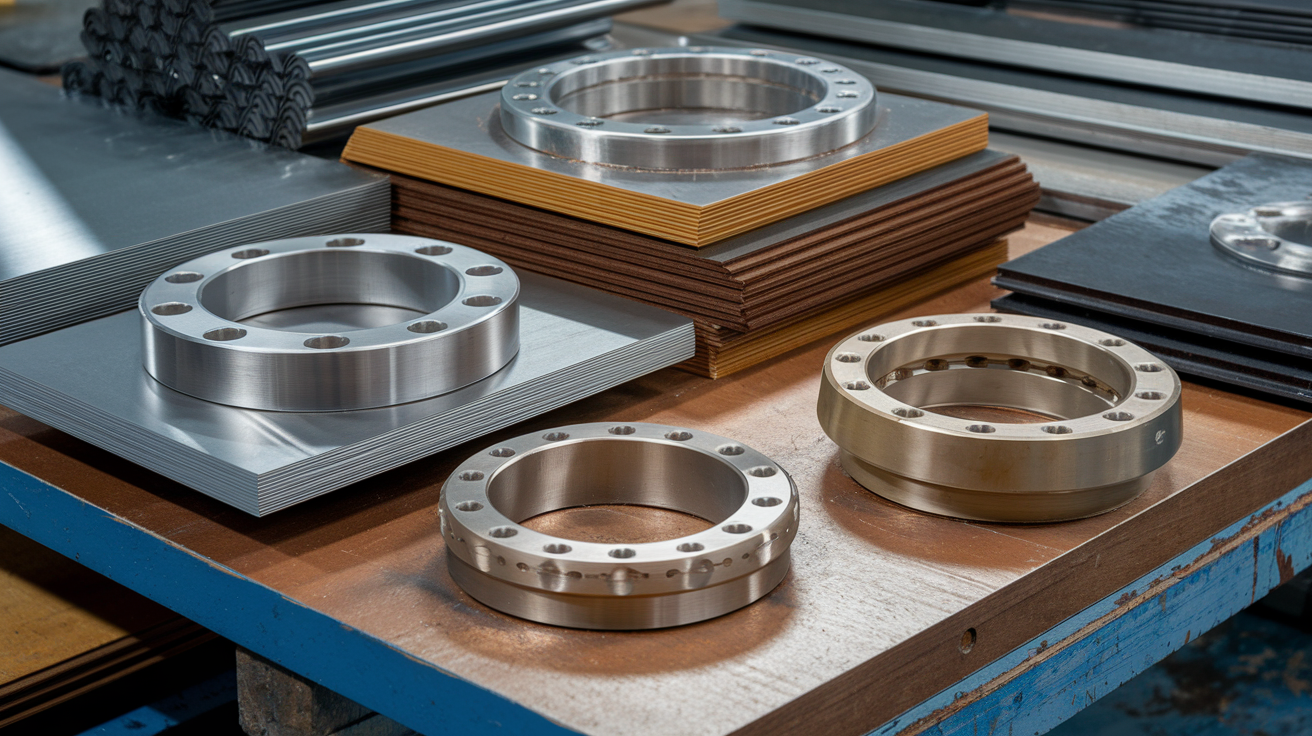
Material Considerations
Now that we’ve covered the suitable applications for each flange type, it’s essential to understand how material selection impacts flange performance and longevity in various environments.
Available Steel Types and Grades
Flange materials play a critical role in ensuring the durability and functionality of piping systems. They must withstand heat, pressure, vibrations, and corrosion while maintaining a leak-proof seal. Several common materials include:
Aço carbono: The most prevalent material due to its strength and cost-effectiveness. Suitable for moderate to high-pressure systems and ambient to high-temperature applications in non-corrosive or mildly corrosive environments. ASTM A36 is a common specification for low-carbon steel flanges.
Aço inoxidável: Offers enhanced corrosion resistance and durability, making it ideal for chemical processing and food and beverage industries. ASTM A182 covers stainless steel and alloy flanges.
Aço de liga leve: Particularly chrome molybdenum types, recommended for high-temperature and high-pressure environments. Essential in oil and gas industry and chemical processing plants.
Duplex and Super Duplex Stainless Steel: Provide superior strength and exceptional corrosion resistance, making them ideal for aggressive environments and high-strength applications.
Nickel Alloy: Features exceptional properties in extreme conditions, including high temperatures and corrosive environments. Suitable for nuclear power plants and marine applications.
Aluminum: Preferred for lightweight applications like irrigation systems.
Ductile Iron: Cost-effective with higher yield strength, suitable for non-contact applications.
Material Selection Based on Application
When selecting the appropriate flange material, consider these factors:
- Medium Type: The substance flowing through the pipes affects material compatibility
- Temperature and Pressure: Different materials have varying tolerance levels
- Condições ambientais: Exposure to corrosive elements or extreme weather
- Maintenance Requirements: Some materials require more frequent inspection
- Budget Constraints: Premium materials like forged flanges offer higher strength but at increased cost
Manufacturing methods also impact material performance:
- Plate Flanges: Cost-effective but lack strength and material variety
- Cast Flanges: Produced from molten metal, providing flexibility at lower cost but with less strength
- Forged Flanges: Made by heating and shaping the material, offering the highest strength at premium pricing
Compliance with Industry Standards
Several organizations establish standards that dictate the chemical composition and specifications for flange materials:
- ASTM: Provides specifications like ASTM A36 for low-carbon steel and ASTM A240 for stainless steel and alloy flanges
- AWWA: Sets standards for water works applications
- ANSI/ASME: Establishes pressure-temperature ratings through standards like ASME B16.5, with constant dimensions across pressure classes
Dimensional standards for metallic flanges and bolt hole patterns include:
- ASME B16.1 for cast iron
- ASME B16.5 for various steel classes
- ASME B16.47 for larger flanges
- MSS SP-44 for smaller steel pipeline flanges
Material limitations specify that flanges must be castings, forgings, or plates, with bolting materials conforming to ASME B16.5. For both WN and slip-on flanges, ensuring compliance with these standards is essential for safety, performance, and interchangeability across systems.

When choosing between WN flanges and slip-on flanges, the decision ultimately depends on your specific application requirements. Weld neck flanges offer superior strength—about one-third greater fatigue life and 50% more strength under pressure compared to slip-on flanges—making them ideal for high-pressure, high-temperature systems in critical industries like petrochemicals and power generation. Their tapered design and full-penetration butt welds ensure excellent stress distribution and minimal flow restriction, though they require more skilled installation and higher initial investment.
Slip-on flanges, while less robust, provide cost-effective solutions for low to medium-pressure systems in non-critical applications such as water treatment and HVAC. Their simpler installation process and lower upfront costs make them attractive for projects where budget constraints are significant. Before making your selection, carefully evaluate your system’s pressure and temperature requirements, material considerations, installation capabilities, and long-term maintenance needs. The right choice will balance performance requirements with budget constraints, ensuring your piping system operates safely and efficiently for years to come.
